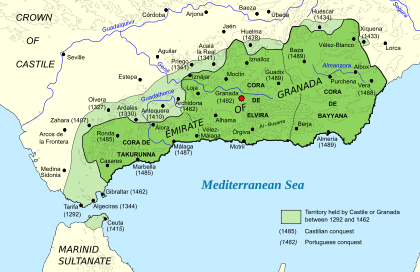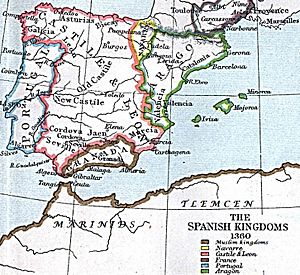Yusuf II of Granada facts for kids
Quick facts for kids Yusuf II |
|||||
|---|---|---|---|---|---|
| Sultan of Granada | |||||
| Reign | 15 January 1391 – 5 October 1392 (10 Safar 793 – 16 Dhu al-Qa'da 794 AH) |
||||
| Predecessor | Muhammad V | ||||
| Successor | Muhammad VII | ||||
| Born | c. 1356 | ||||
| Died | 5 October 1392 (age about 36) Granada |
||||
| Spouse | Several, names unknown; Khadija (possible) | ||||
| Issue | Yusuf III Muhammad VII Ali Ahmad Umm al-Fath Ismail III (possible) |
||||
|
|||||
| Dynasty | Nasrid | ||||
| Father | Muhammad V | ||||
| Religion | Islam | ||||
Abu al-Hajjaj Yusuf ibn Muhammad (Arabic: أبو الحجاج يوسف بن محمد; born around 1356 – died 5 October 1392) was a ruler known as the sultan of the Emirate of Granada. This emirate was the last Muslim state in the Iberian Peninsula, which is now Spain and Portugal.
Yusuf II ruled Granada from January 1391 until his death. He was the 11th sultan from the Nasrid dynasty. He was also the first son of the previous sultan, Muhammad V, who ruled for many years.
When Yusuf was about three years old, his father lost his throne. The family had to go into exile in Fez, the capital of the Marinid Sultanate in Morocco. His father got his throne back in 1362. Young Yusuf was then put in charge of the Volunteers of the Faith. These were North African soldiers who helped fight for the emirate.
Yusuf became sultan after his father passed away in 1391. At first, his government was largely controlled by his minister, Khalid. However, Khalid was later suspected of plotting against the sultan and was removed from his position. Yusuf then took full control of his government. In July 1392, he appointed the famous poet Ibn Zamrak as his new chief minister. Ibn Zamrak had been imprisoned by Yusuf earlier.
Yusuf continued the peace agreement his father had made with Castile, a Christian neighbor. He also signed a new treaty with another Christian ruler, John I of Aragon, in August 1392. Yusuf II died on 5 October 1392, after ruling for less than two years. Some old Christian writings suggest he was killed by a poisoned tunic. Modern historians think poisoning is possible, but they are not sure if the story of the tunic is true. After Yusuf's death, his son Muhammad VII became sultan, followed later by another son, Yusuf III.
Contents
Early Life and Family's Journey
Yusuf was the first son of Muhammad V of Granada. He was the only child born during his father's first time as sultan. Historians believe he was born around 1356.
When Yusuf was about three years old, his father was removed from power. This happened on August 23, 1359. A group of men climbed the walls of the Alhambra palace that night. They put Muhammad V's half-brother, Ismail II, on the throne.
Yusuf was walking with his father in the Generalife gardens near the Alhambra. This allowed his father to escape to Guadix in eastern Granada. From there, they traveled across the Mediterranean Sea to Fez. Yusuf was left behind in Granada at first. But around November 25, the new sultan allowed Yusuf and his mother to join his father in Fez.
Muhammad V returned to al-Andalus in August 1361. He set up a rival court in Ronda, a town controlled by the Marinids. This started a civil war against Muhammad VI, who had taken the throne from Ismail II. Muhammad V, with help from Peter of Castile, gained the upper hand. Muhammad VI fled the Alhambra and sought safety with Peter in March 1362. Muhammad V then entered the royal palace and became sultan again. Muhammad VI was killed by Peter in April.
Coming Back to Granada
Yusuf was still in Fez when his father became sultan again. The new Marinid Sultan, Abu Zayyan Muhammad, tried to use Yusuf as a way to get Muhammad V to return Ronda. But the Marinids gave in. Yusuf was allowed to return to Granada with his father's chief minister, Ibn al-Khatib. Ibn al-Khatib had also been in exile in Morocco. Ronda remained under Granada's control.
Yusuf and his group arrived in Granada, the capital city, on June 14, 1362. His younger brothers, Abu Nasr Sa'd, Nasr, and Abu Abdullah Muhammad, were born later.
In June 1363, Muhammad V removed Yahya ibn Umar from his position as chief of the Volunteers of the Faith. These were North African soldiers fighting for Granada. Usually, their chief was a prince from the Berber Marinid dynasty. However, the sultan appointed his young son Yusuf as the new chief. His brother Sa'd became a commander. Yusuf also received a special estate from his father that was free from taxes.
Muhammad V had one of the longest reigns in the Nasrid dynasty. Around the time Yusuf became an adult, he was held and questioned. People suspected him of planning to rebel against his father. However, after an investigation, he was found innocent. In 1390, his father and John I of Castile signed a treaty to keep peace between their kingdoms. Yusuf and John's son Henry also signed this agreement. Yusuf was about 35 years old when his father died in January 1391.
Becoming Sultan
Yusuf II became sultan on January 15, 1391, the same day his father died. He took the royal name al-Mustaghni bi-llah, meaning "He who is satisfied with God." On that day, he sent a letter to Alonso Yáñez de Fajardo, a Castilian official. The letter confirmed that the peace agreement Muhammad V had signed with John I in 1390 would continue. Even though treaties usually ended when a ruler died, this one stayed because both Yusuf and Henry III had also signed it.
Yusuf also kept peace with Aragon. Its king, John I of Aragon, had been on good terms with Muhammad V. In March 1391, Yusuf sent a letter to the Aragonese king. He told John about his father's death and his own new role as sultan. The king replied with the usual messages of sympathy. He also mentioned he was surprised it took Yusuf so long to send the letter.
During his first year as sultan, Yusuf imprisoned the poet Ibn Zamrak. Ibn Zamrak had been his father's chief minister. Yusuf's rule was heavily influenced by Khalid, his father's trusted servant. Khalid became Yusuf's first minister. Khalid also imprisoned the sultan's three brothers. Yusuf never heard about them again, and they died while in prison.
Yusuf later received a report that Khalid was plotting against him. The report also suggested that Yahya ibn al-Saigh, the Jewish royal doctor, was involved in a plan to poison him. The sultan ordered both of them to be removed. Khalid was killed in front of Yusuf. Yahya was imprisoned and later died.
After this, Yusuf took full control of his government. A few months before his death, he faced another plot. This one was led by his own son, Muhammad, who would later become Muhammad VII. Their disagreement was settled peacefully with help from the Marinid sultan Abu al-Abbas Ahmad. Muhammad then accepted his father's authority.
In July 1392, Yusuf brought Ibn Zamrak back as his chief minister. On August 14, he signed a five-year peace treaty with Aragon. This treaty was similar to earlier agreements. It seemed to help the Muslim people living in Aragon. Two weeks later, King John I allowed them to appear in public without a special badge they used to have to wear. On August 29, John wrote a letter allowing Muslims from Zaragoza to send a representative to Granada's court. However, this letter was never sent. This was probably because the king worried it might give Granada an excuse to get involved in his country's affairs.
His Family
We do not know the names of Yusuf's mother or his wives. Yusuf's first son was Yusuf III. Muhammad VII was born soon after. Other sons included Abu al-Hasan Ali and Abu al-Abbas Ahmad. He also had a daughter named Umm al-Fath. She later married Muhammad IX.
Some historians believe Yusuf also had another son who became sultan, Ismail III of Granada. However, other historians say Ismail's family tree is not clear. Not all of Yusuf's children had the same mother. For example, Muhammad VII was a half-brother to Yusuf III and Umm al-Fath. This shows that Yusuf II had more than one wife.
A 16th-century book called History of the Royal House of Granada mentions a "Muhammad Guadix" as the eleventh sultan of Granada who died in 1392. It says he married Khadija, the daughter of Sultan Abu al-Abbas Ahmad II from the Hafsid dynasty. This marriage supposedly produced a son named Yusuf, who also became sultan. Because "Muhammad Guadix"'s death year matches Yusuf II's, some historians think the Christian source might have confused Yusuf II with this name. This could mean Khadija was one of Yusuf II's wives and the mother of Yusuf III. Another old story says Yusuf II married a daughter of the King of Fez.
How He Died
Yusuf died on October 5, 1392, when he was about 36 years old. A later Castilian book, the Chronicle of John II, claims he was killed by a poisoned tunic. This tunic was supposedly among gifts sent by the Marinid Sultan Abu al-Abbas.
This claim came from a letter written by Fernán Sánchez. Sánchez was a Christian who lived in Granada during the time of Yusuf III. Sánchez wrote that he "saw with [his] own eyes" in Granada that the sultan felt sick right after putting on the tunic. He then "died within thirty days, with his flesh coming off in pieces."
No other historical records confirm this story. Also, Sánchez wrote many similar stories about people being killed with poisoned clothes. Because of this, historian L. P. Harvey is hesitant to believe the report is true. Another historian, Francisco Vidal Castro, says that even though the details might be exaggerated, it is possible that Yusuf was poisoned. Vidal Castro notes that the Marinid Sultanate was known for getting involved in Granada's affairs. It's possible that Yusuf's son and successor, Muhammad VII, might have worked with the Marinids or other people at court to poison his father and take the throne.
See also
 In Spanish: Yusuf II de Granada para niños
In Spanish: Yusuf II de Granada para niños




